Abstract
Recent epidemiologic studies have reported associations between the consumption of chlorinated drinking water and reproductive and developmental effects. Here we review the available epidemiologic data, assess the hazard potential posed by exposure to disinfection by-products, identify critical data gaps, and offer recommendations for further research. The epidemiologic evidence supporting associations between exposure to water disinfection by-products (DBPs) and adverse pregnancy outcomes is sparse, and positive findings should be interpreted cautiously. The methods used during the early stages of research in this area have been diverse. Variability in exposure assessment and endpoints makes it difficult to synthesize or combine the available data. Exposure misclassification and unmeasured confounding may have lead to bias in risk estimation. Future studies of reproductive outcome and exposure to chlorinated water should use improved methods for exposure assessment to 1) assure selection of appropriate exposure markers, 2) assess seasonal and annual fluctuations in DBPs, 3) assess variability within the distribution system, and 4) assess exposure through multiple routes such as bathing and showering, as well as consumption. Population-based studies should be conducted to evaluate male and female fertility, conception delay, growth retardation, and specific birth defects. The reproductive and developmental effects of exposure to DBPs could be efficiently explored in ongoing investigations by incorporating valid exposure markers and relevant questionnaire information. Future studies should make use of naturally occurring variability in the concentrations of DBPs and may incorporate biomarkers of exposure and effect in their design. Epidemiologic investigations should be conducted in parallel with laboratory-based and animal studies in a coordinated, multidisciplinary approach.
Full text
PDF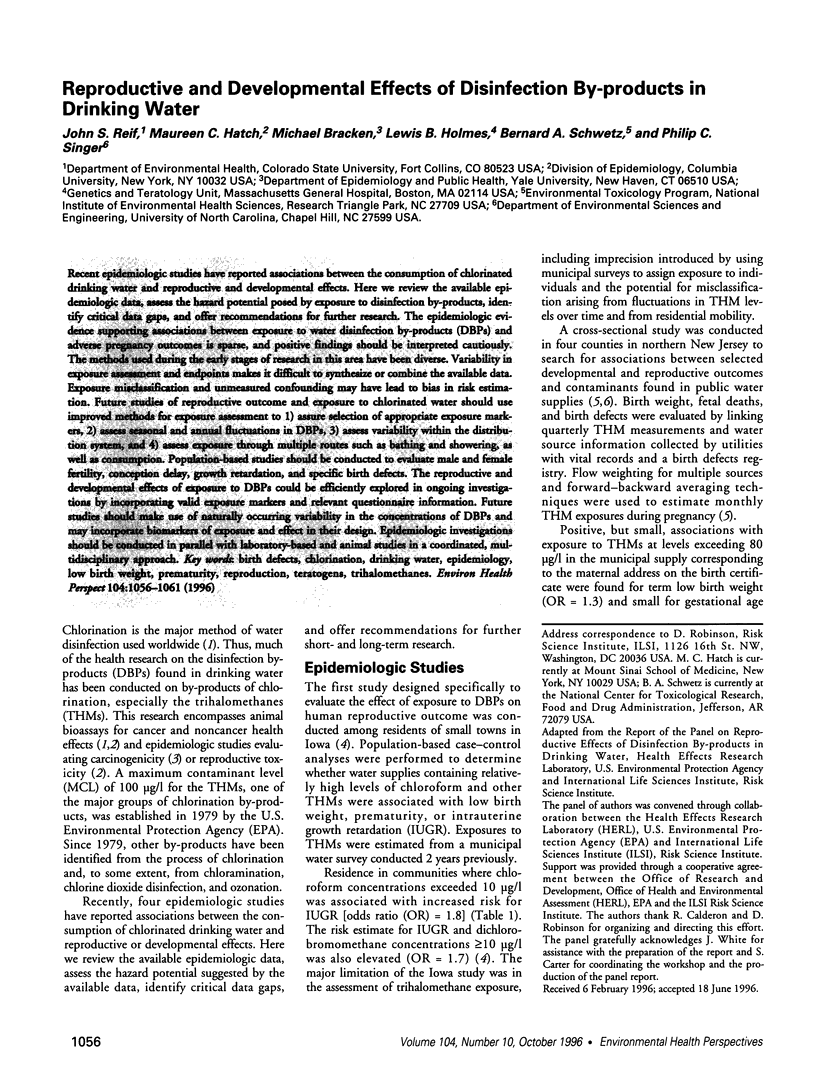
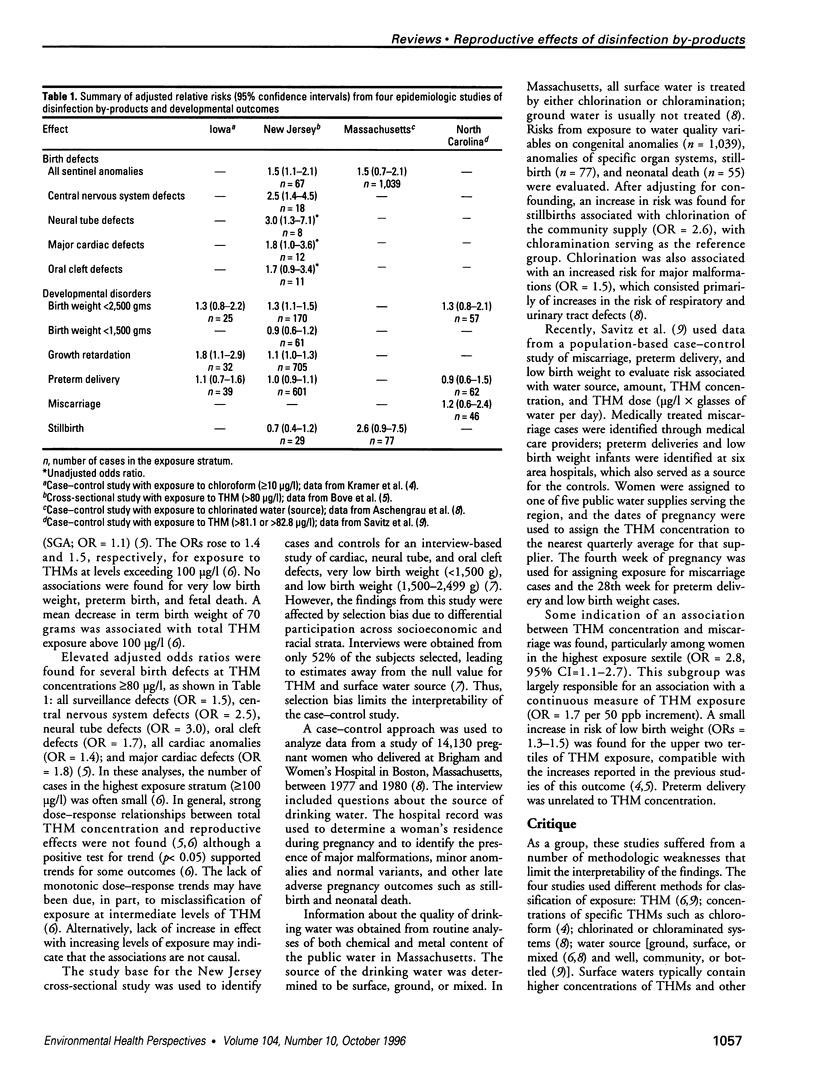
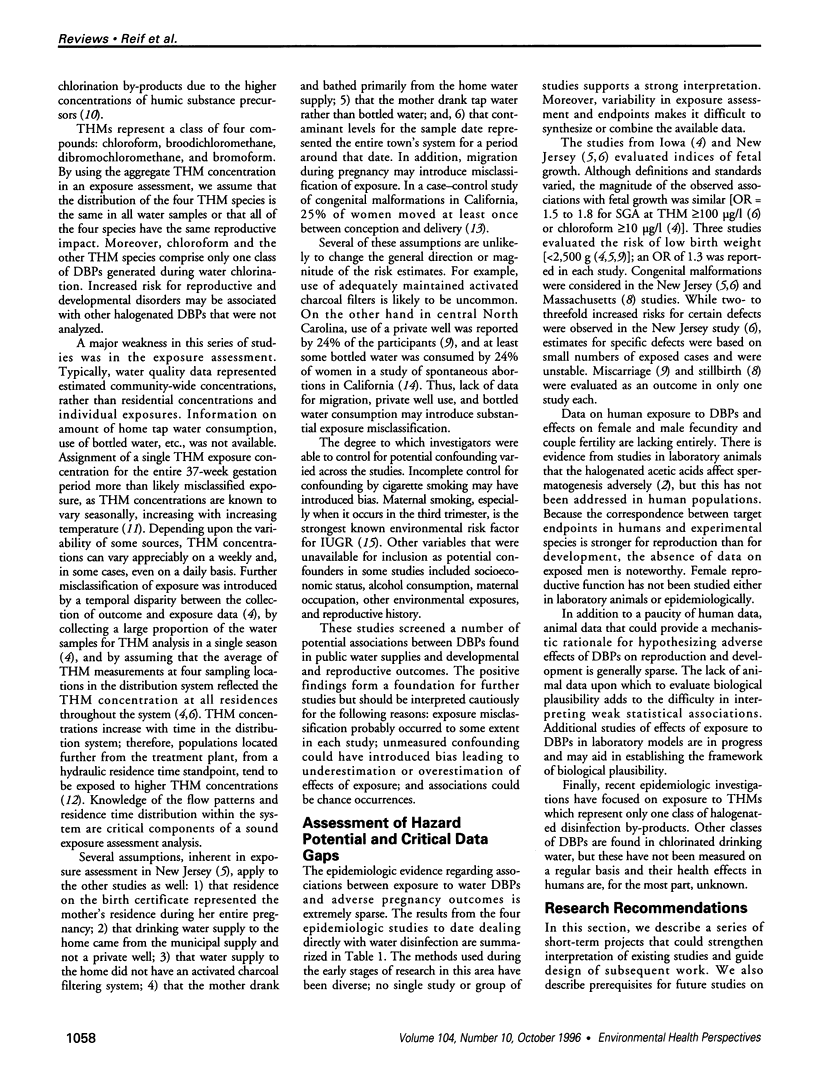
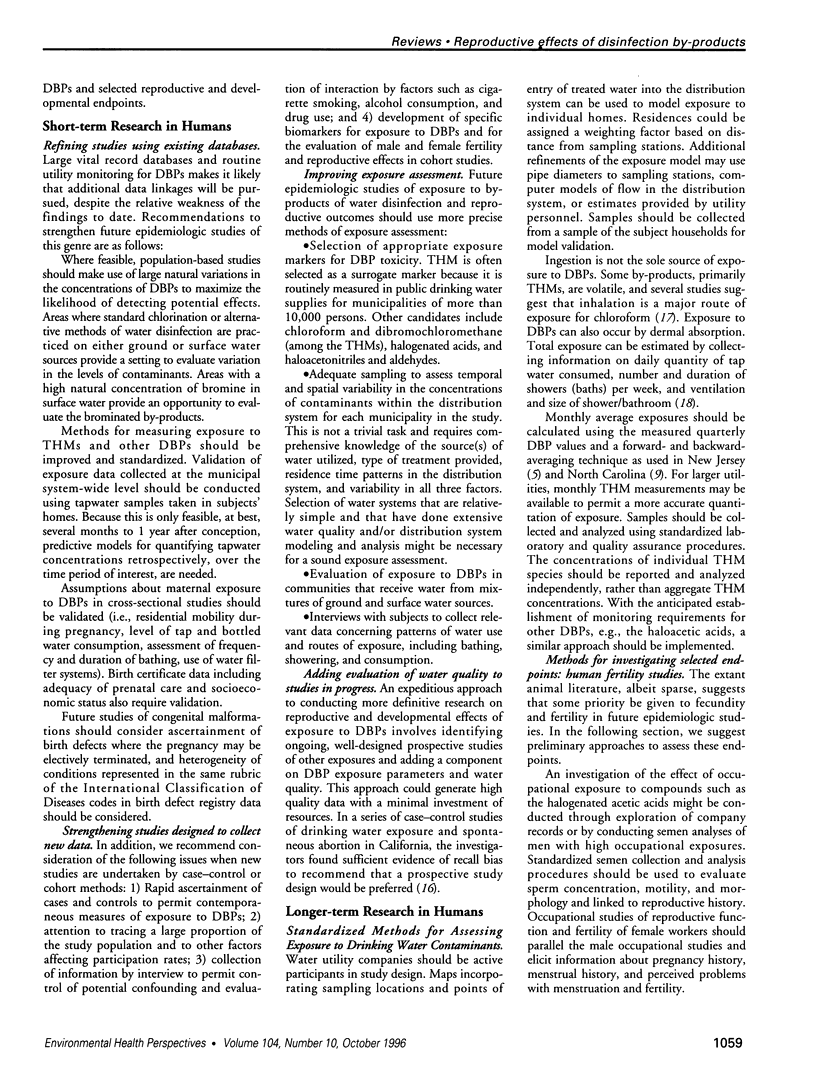
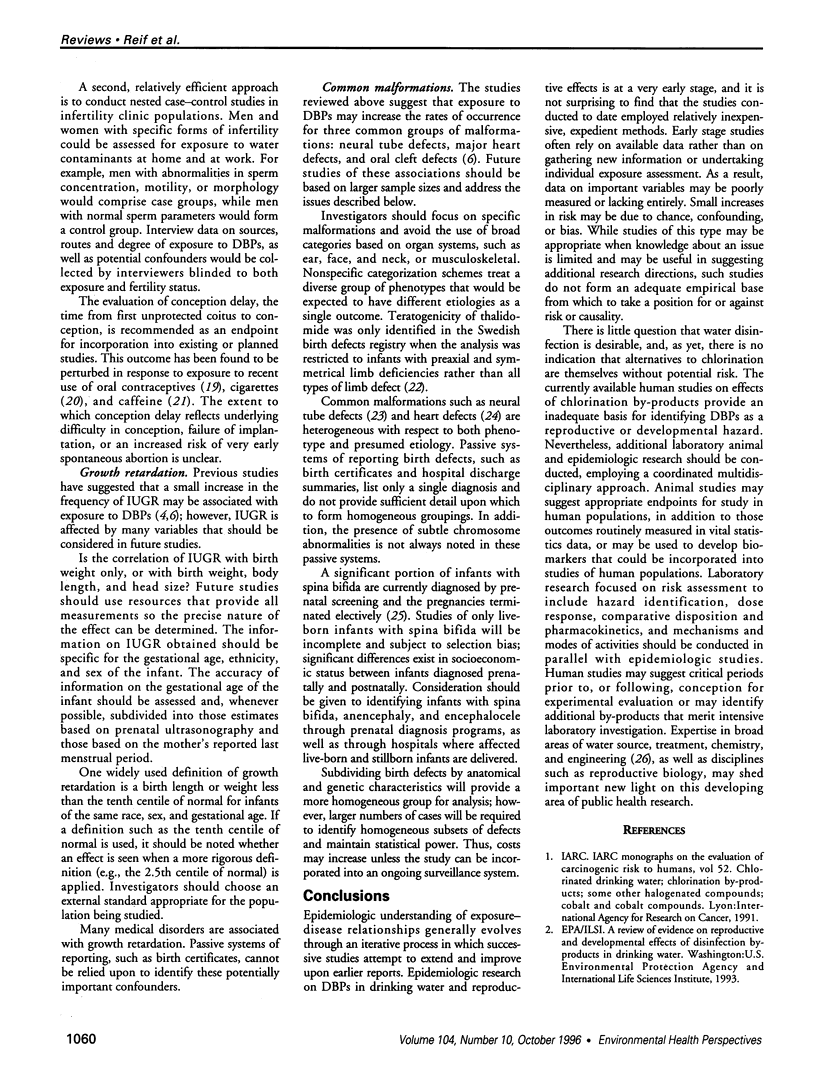
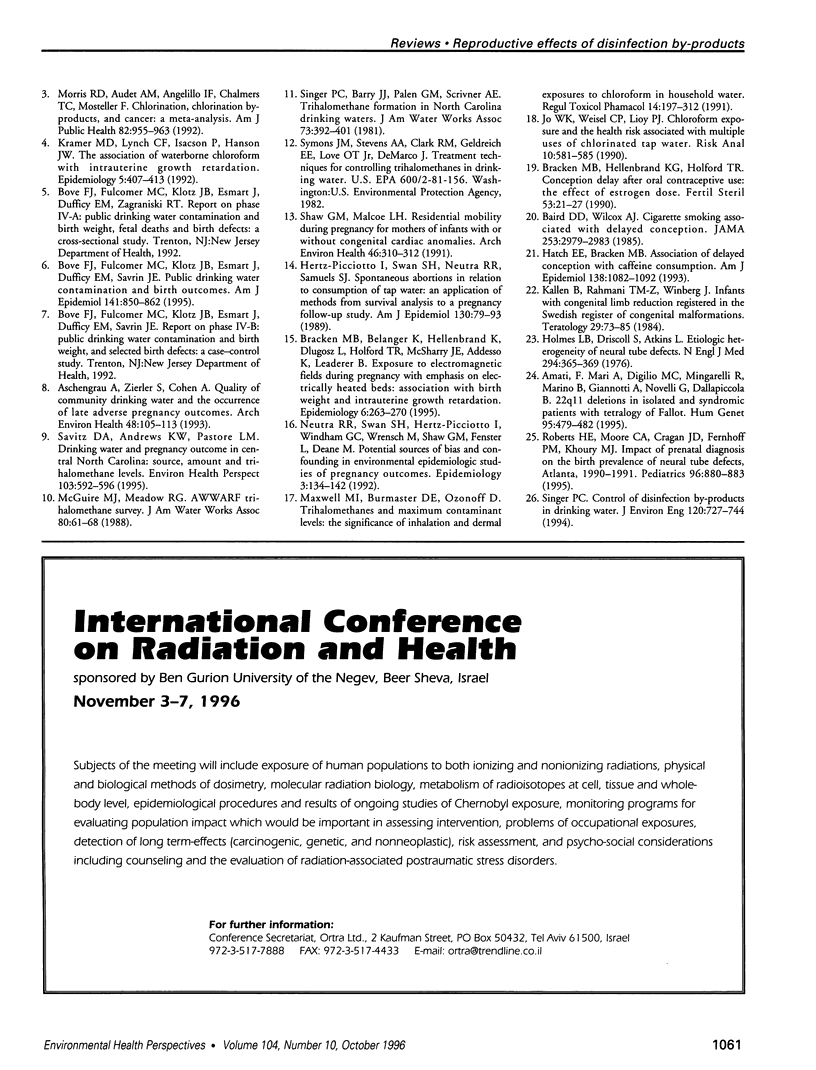
Selected References
These references are in PubMed. This may not be the complete list of references from this article.
- Amati F., Mari A., Digilio M. C., Mingarelli R., Marino B., Giannotti A., Novelli G., Dallapiccola B. 22q11 deletions in isolated and syndromic patients with tetralogy of Fallot. Hum Genet. 1995 May;95(5):479–482. doi: 10.1007/BF00223856. [DOI] [PubMed] [Google Scholar]
- Aschengrau A., Zierler S., Cohen A. Quality of community drinking water and the occurrence of late adverse pregnancy outcomes. Arch Environ Health. 1993 Mar-Apr;48(2):105–113. doi: 10.1080/00039896.1993.9938403. [DOI] [PubMed] [Google Scholar]
- Baird D. D., Wilcox A. J. Cigarette smoking associated with delayed conception. JAMA. 1985 May 24;253(20):2979–2983. [PubMed] [Google Scholar]
- Bove F. J., Fulcomer M. C., Klotz J. B., Esmart J., Dufficy E. M., Savrin J. E. Public drinking water contamination and birth outcomes. Am J Epidemiol. 1995 May 1;141(9):850–862. doi: 10.1093/oxfordjournals.aje.a117521. [DOI] [PubMed] [Google Scholar]
- Bracken M. B., Belanger K., Hellenbrand K., Dlugosz L., Holford T. R., McSharry J. E., Addesso K., Leaderer B. Exposure to electromagnetic fields during pregnancy with emphasis on electrically heated beds: association with birthweight and intrauterine growth retardation. Epidemiology. 1995 May;6(3):263–270. doi: 10.1097/00001648-199505000-00013. [DOI] [PubMed] [Google Scholar]
- Bracken M. B., Hellenbrand K. G., Holford T. R. Conception delay after oral contraceptive use: the effect of estrogen dose. Fertil Steril. 1990 Jan;53(1):21–27. [PubMed] [Google Scholar]
- Hatch E. E., Bracken M. B. Association of delayed conception with caffeine consumption. Am J Epidemiol. 1993 Dec 15;138(12):1082–1092. doi: 10.1093/oxfordjournals.aje.a116826. [DOI] [PubMed] [Google Scholar]
- Hertz-Picciotto I., Swan S. H., Neutra R. R., Samuels S. J. Spontaneous abortions in relation to consumption of tap water: an application of methods from survival analysis to a pregnancy follow-up study. Am J Epidemiol. 1989 Jul;130(1):79–93. doi: 10.1093/oxfordjournals.aje.a115325. [DOI] [PubMed] [Google Scholar]
- Holmes L. B., Driscoll S. G., Atkins L. Etiologic heterogeneity of neural-tube defects. N Engl J Med. 1976 Feb 12;294(7):365–369. doi: 10.1056/NEJM197602122940704. [DOI] [PubMed] [Google Scholar]
- Jo W. K., Weisel C. P., Lioy P. J. Chloroform exposure and the health risk associated with multiple uses of chlorinated tap water. Risk Anal. 1990 Dec;10(4):581–585. doi: 10.1111/j.1539-6924.1990.tb00542.x. [DOI] [PubMed] [Google Scholar]
- Kramer M. D., Lynch C. F., Isacson P., Hanson J. W. The association of waterborne chloroform with intrauterine growth retardation. Epidemiology. 1992 Sep;3(5):407–413. doi: 10.1097/00001648-199209000-00005. [DOI] [PubMed] [Google Scholar]
- Källén B., Rahmani T. M., Winberg J. Infants with congenital limb reduction registered in the Swedish Register of Congenital Malformations. Teratology. 1984 Feb;29(1):73–85. doi: 10.1002/tera.1420290109. [DOI] [PubMed] [Google Scholar]
- Maxwell N. I., Burmaster D. E., Ozonoff D. Trihalomethanes and maximum contaminant levels: the significance of inhalation and dermal exposures to chloroform in household water. Regul Toxicol Pharmacol. 1991 Dec;14(3):297–312. doi: 10.1016/0273-2300(91)90032-q. [DOI] [PubMed] [Google Scholar]
- Morris R. D., Audet A. M., Angelillo I. F., Chalmers T. C., Mosteller F. Chlorination, chlorination by-products, and cancer: a meta-analysis. Am J Public Health. 1992 Jul;82(7):955–963. doi: 10.2105/ajph.82.7.955. [DOI] [PMC free article] [PubMed] [Google Scholar]
- Neutra R. R., Swan S. H., Hertz-Picciotto I., Windham G. C., Wrensch M., Shaw G. M., Fenster L., Deane M. Potential sources of bias and confounding in environmental epidemiologic studies of pregnancy outcomes. Epidemiology. 1992 Mar;3(2):134–142. doi: 10.1097/00001648-199203000-00012. [DOI] [PubMed] [Google Scholar]
- Roberts H. E., Moore C. A., Cragan J. D., Fernhoff P. M., Khoury M. J. Impact of prenatal diagnosis on the birth prevalence of neural tube defects, Atlanta, 1990-1991. Pediatrics. 1995 Nov;96(5 Pt 1):880–883. [PubMed] [Google Scholar]
- Savitz D. A., Andrews K. W., Pastore L. M. Drinking water and pregnancy outcome in central North Carolina: source, amount, and trihalomethane levels. Environ Health Perspect. 1995 Jun;103(6):592–596. doi: 10.1289/ehp.95103592. [DOI] [PMC free article] [PubMed] [Google Scholar]


